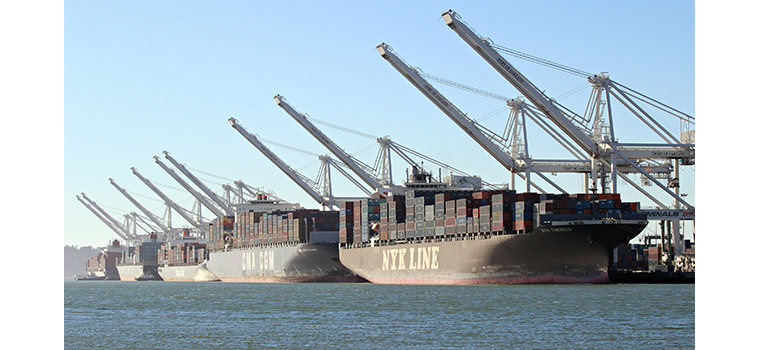It's been all good news for the Port of Oakland recently, as Moody's Investors Service has upgraded its bond ratings and assigned ratings on an upcoming series of refunding revenue bonds.

The Port of Oakland’s containerized import volume reached a two-year high in May. Photo courtesy of Port of Oakland.
BY PATRICK BURNSON
Published: July, 2017
It’s been all good news for the Port of Oakland recently, as Moody’s Investors Service has upgraded its bond ratings and assigned ratings on an upcoming series of refunding revenue bonds. The upgrades, announced June 9, include: $656 million of senior lien bonds to A1 from A2; $324 million of intermediate lien bonds to A2 from A3; and a subordinate lien bank note rating to A3 from Baa1.
Moody’s assigned an A2 rating on four series of intermediate lien refunding revenue bonds expected to be sold June 21. The port said proceeds from the sale would be used to refund the port’s 2007 intermediate lien bonds.
Moody’s said the port’s outlook is stable. “The stable outlook reflects our expectation of stability in air passenger traffic and marine cargo volume; ongoing vitality in the regional economy; and manageable risk in the maritime division due to the landlord model employed, which will support financial stability through a period of operational transition and potential short term revenue volatility,” Moody’s said in an announcement.
Moody’s said the upgrades reflect significant improvement in the port’s credit profile, driven by a long-term and ongoing deleveraging, strengthened activity levels, improved debt service coverage ratios and a materially improved cash position.
More Inbound Volume
Meanwhile, the Port of Oakland’s containerized import volume reached a two-year high in May. The port said it handled the equivalent of 82,440 20-foot import containers, up 1.4 percent from May 2016. It was the highest volume since August 2015, when the port handled the equivalent of 82,492 20-foot import boxes.
Imports account for 48 percent of containers shipped through Oakland. “Our import volume has been up four consecutive months,” said Port of Oakland Maritime Director John Driscoll. “That’s encouraging as we head into the traditionally busy summer-fall peak season.”
The port said overall volume—imports, exports and empty containers—grew 2.2 percent during the first five months in 2017 compared to the same period last year. Meanwhile, the number of vessels visiting Oakland was down seven percent.
Despite the fact that fewer vessels called the Port of Oakland, container volumes are growing due to the fact that the ships are larger—as reported in last month’s Bay Crossings. For example, megaships capable of transporting up to 14,000 20-foot containers come to Oakland weekly now.
Brendan R. McCahill, the senior vice president of trade data content at Descartes Datamyne, said the calling of these mega-vessels are a “game changer” for many ports in the United States. In the research firm’s latest rankings, Oakland finished ninth.
Port of Oakland Makes Balanced Moves
Port of Oakland Executive Director Chris Lytle has said that he wants more rail business at the port. He told a meeting of railroad executives in San Francisco in late May that the port is poised to make it happen.
“We have two outstanding partners at the port in the Union Pacific and Burlington Northern Santa Fe railroads,” Lytle told the annual meeting of the North American Rail Shippers Association. “And everyone in Oakland would like to see more cargo move in and out of the city on the rails than over the road.” Lytle said that rail traffic takes trucks off the road, reducing freeway congestion and diesel emissions.
Oakland’s executive director briefed more than 270 industry leaders and cargo owners on the state of West Coast ports. He said Oakland is building momentum following a record year for loaded container volume in 2016. He added, however, that there’s plenty of room to grow on the rails.
Ports rely on railroads or trucks to transport ocean shipments to and from the docks. Lytle said both major West Coast railroads operate at far less than capacity in Oakland. The reason, he said, is that the port’s primary market for containerized cargo is Northern California, which is more efficiently served by trucks than trains. But he added that Oakland’s rail profile could improve soon thanks to recent investments at the port.
Late last year, the port completed a $100 million rail storage yard with 41,000 feet of tracks. The facility, within sight of Oakland marine terminals, should be ideally located for export shippers, Lytle said. He envisioned 100-car grain trains rolling into Oakland, then transferring cargo to containers for ocean transport.
In mid-2018, Cool Port Oakland will open, Lytle said. The 300,000-square-foot refrigerated facility will be the pivot point for exporting beef, pork and chicken to Asia. Those shipments will likely come from the Midwest in rail cars, then go into ocean containers at Cool Port Oakland. Lytle said the facility would be able to handle 36 refrigerated rail cars at one time.
Construction happening next door to the port could generate even more rail traffic, Lytle said. Business developments are going up on city-owned land that was formerly part of the Oakland Army Base. They could attract cargo shipped in bulk—not a staple at the port, but a likely candidate for the port’s rail yard.
Patrick Burnson is the executive editor of Logistics Management www.logisticsmgmt.com

